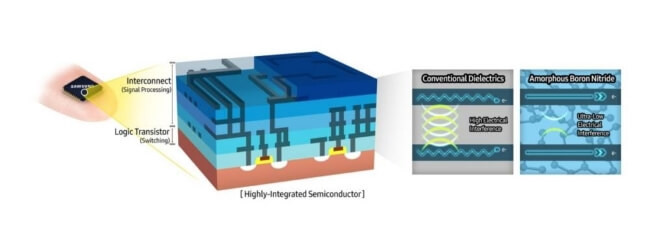Meet Amorphous Boron Nitride – The Future Dielectric
| 22-07-2020 | By Robin Mitchell
Samsung announced the discovery of a material called amorphous boron nitride which is claimed to be the future dielectric for semiconductors. What role do dielectric materials play, and why are they becoming increasingly important in modern devices?
What is a Dielectric? - Dielectric Constant, Dielectric Strength, and More
A dielectric material is an insulator that does not allow current flow through it but instead orients its molecules in-line with an applied electric field thus becoming polarised. In semiconductors, a dielectric is an insulating layer that prevents the flow of current. The dielectric constant of a material, called relative permittivity, indicates how easily a material can be polarised. A larger dielectric permittivity generally indicates a weaker insulator but will allow for a higher capacity capacitor if used as the dielectric in a capacitor. Essentially, dielectric strength means the total maximum voltage necessary to generate a dielectric breakdown through a material.
Why are Dielectrics Important?
One of the biggest problems currently faced with semiconductors are related to quantum effects called "tunnelling". If two wires each with an insulating layer are wrapped around each other, the current in one wire cannot cross into the other wire thanks to the insulating layer. The use of dielectrics as insulators is what made the first semiconductor devices possible; microcircuits could be etched into insulating layers to prevent short-circuits. However, if the insulating layer between the two wires is in the nanometres, then electrons can "teleport" across the insulating layer, thus forming a current. This is the problem that modern devices face; their insulating layers are becoming so thin that electrons can quantum tunnel across.
The tunnelling effect is dependent on how good of an insulator is used, and the strength of an insulator is related to the material's dielectric. Materials that have a large dielectric constant will be more susceptible to quantum tunnelling, which is why semiconductor manufacturers are always looking for materials with a low dielectric constant.
Introducing Amorphous Boron Nitride
Samsung has recently announced their joint discovery in a new dielectric material that is said to be a potential game-changer in next-generation semiconductor devices. The material, known as Amorphous Boron Nitride, has an incredibly low dielectric constant of 1.78 and boasts strong electrical and mechanical properties. The use of such a dielectric not only helps to prevent electron tunnelling but also reduces the interference caused by near-by electrical conductors.

An amorphous material is one that does not follow an orderly structure that is observed in crystalline structures. For example, salt crystals in the nanometer scale are identical in shape to those in the mm scale, and each crystal has the same internal structure. An amorphous material, however, does not follow this and can be completely random in how the atoms form bonds. The new dielectric material shows promise not just because of its dielectric constant, but the fact that it can be grown in temperatures as low as 400°C. This is critical as this temperature allows for the growth of the crystals on top of a wafer without profoundly affecting other layers already present on the wafer. The ability to grow the material has also been demonstrated on a wafer scale, meaning that its addition to a production line should be straight forward. Samsung hopes to integrate the new material into the next-generation DRAM and NAND ICs.
"Recently, interest in 2D materials and the new materials derived from them has been increasing. However, there are still many challenges in applying the materials to existing semiconductor processes. We will continue to develop new materials to lead the semiconductor paradigm shift."
-
Seongjun Park, Vice President and Head of Inorganic Material Lab, SAIT.
Read More

